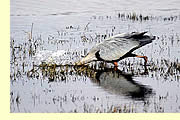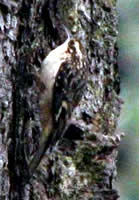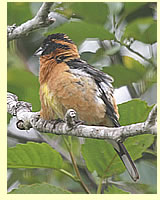





GOLDEN GATE PARK BIRDS

Golden Gate Park is one of America's great urban parks. It's a complex, changing blend of the natural and artificial. A 1868 local newspaper described the new park as a "dreary waste of shifting sandhills where a blade of grass cannot be raised without four posts to keep it from blowing away." Apt words. In the 1870s the park builders found a way to stop the shifting sand. They planted a mixture of fast-growing rye-grass and longer lasting, native lupines. The rye-grass sprouted quickly and densely, holding the sand in place until the long-lived lupine got big and strong enough to hold down the sand. Then followed trees and larger bushes.
There were originally fourteen natural lakes in the thousand-plus acres that made up Golden Gate Park. Elk Glen and Chain of Lakes are reshaped survivors of those prehistoric ponds. The trees at the west end of park are all the result of gardening.
Golden Gate Park has long been a favorite of birders. Florence Merriam Bailey wrote the first true field guide to western birds (1902) and her book mentions species seen in Golden Gate Park: Bushtits, Golden-crowned Sparrows, Fox Sparrows and California Quail. The park is still frequented by birders, and an occasional vagrant oriole or warbler brings birders from across the state. Yet, only one slender book has been written about Golden Gate Park's birds.
The 84-page Handbook of the Birds of Golden Gate Park was published in 1930 by the California Academy of Sciences. The author: 73-year old Joseph Mailliard, curator emeritus of ornithology of the Academy. During his life Mailliard wrote over 150 scientific articles, largely on California fauna. He grew up on his family's ranch in Marin's San Geronimo Valley. At age 62, after years of dedicated field work as an amateur, Mailliard became curator of ornithology at the Academy. That was 1919.
In his handbook Mailliard lists 111 species for Golden Gate Park. Here are some of the observations he made, and a look at what's changed or remained the same.
Among Grebes he said Eared and Pied-billed were common. The Horned he said had never been reported in the park. The Pied-billed remains resident in the park. The Eared and Horned are usually seen on Spreckels at some point every winter.
Maillaird listed twelve ducks:
| Maillaird | Today | |
| Mallard | Abundant | Abundant |
| Am. Wigeon (Baldpate) | Common (Winter) | Common (W) |
| G-W Teal | Occasional (W) | Rare |
| Shoveller | Occasional (W) | Regular (W) - usually Mallard Lake |
| Pintail | Common (W) | Rare |
| Canvasback | Often Numerous (W) | Regular (W) - Spreckels |
| Lesser Scaup | Resident | Regular (W) - Spreckels |
| Ring-necked Duck | Uncommon (W) | Common (W) - Lloyd & Mallard Lakes |
| Bufflehead | Not numerous (W) | Regular (W) |
| White-winged Scoter | Rare (W) | Casual |
| Surf Scoter | Casual (W) | Casual |
| Ruddy Duck | Resident | Common (W) - Spreckels & other lakes |
| Gadwall | not mentioned | Regular - may have bred on Mallard Lake |
| Wood Duck | not mentioned | Casual - usually seen every summer & fall |
| Hooded Merganser | not mentioned | Casual |
| Cinnamon Teal | not mentioned | Regular (W) |
| Tufted Duck | not mentioned | Rare |
| Eurasian Wigeon | not mentioned | Rare |
 The Blue Heron was rare in 1930 and now breeds annually at Stow Lake. The Great Egret was not even mentioned by Mailliard. Now a barely wild Egret can be seen almost every winter day hunting at Lloyd Lake. When Mailliard wrote, the egret family was still recovering from decades of plume-hunters. It had not been fifteen years since the Migratory Bird treaty outlawed plume hunting and during Mailliard's lifetime both the Heron and Egret had nearly disappeared from California.
The Blue Heron was rare in 1930 and now breeds annually at Stow Lake. The Great Egret was not even mentioned by Mailliard. Now a barely wild Egret can be seen almost every winter day hunting at Lloyd Lake. When Mailliard wrote, the egret family was still recovering from decades of plume-hunters. It had not been fifteen years since the Migratory Bird treaty outlawed plume hunting and during Mailliard's lifetime both the Heron and Egret had nearly disappeared from California.
Open fields and wet meadows were more extensive in Mailliard's Golden Gate Park. He listed American Pipits, Killdeer, American Kestrel and Merlin as common. The only dependable place for Pipit in western San Francisco now is Fort Funston. Even Killdeer can be hard to find in winter in Golden Gate Park. Kestrel breed in limited numbers in western San Francisco and may hunt in the park. Every winter Merlin are seen in San Francisco though not usually in Golden Gate Park. Mailliard considered both the Yellowthroat and Yellow Warbler to be common in summer. Now Yellows are abundant only in August and September as they head south, the Yellowthroat is only occasional.
Mailliard found Swainson's Thrush breeding in the park, now they are likely only during migration. Bewick's Wren, a chaparral dweller, was common. Not any more. Now you need to look at Fort Funston. Today the Winter Wren, a forest bird, is likely and may even breed in Golden Gate Park. In 1930 the little Winter Wren was "very rare."
Mailliard also called the Red-shouldered Hawk "very rare." Now it's a noisy, annual breeder in Golden Gate Park, the Presidio and at Land's End. Mailliard's book contains a hint of why this buteo almost disappeared: "The California Academy of Sciences Collection contains two immature birds taken here by the park hunter."
That is the same park hunter who deliberately shot all raptors and Corvids. Steller's Jays were thought to be extirpated. Some were seen in the park in 1998-9 and are now apparently breeding there. Western Scrub Jays also breed in the park in small numbers. In Mailliard's time the Crow was "rare" and he tells us no Raven had ever been reported in Golden Gate Park. In 1944 Joseph Grinnell wrote of the Raven in California, "now scarce or absent in all settled parts of the State. The humanly traditional feeling of hostility against 'crows' includes also ravens, but it is weathered by that sagacious bird in amazing degree."
Well, the big Corvids are back. Both Crows and Ravens began re-colonizing San Francisco in the 1970s. Crows are more common in the eastern end of Golden Gate Park. Ravens are often seen nearer the Pacific and they frequent Ocean Beach. Both are likely annual breeders in the park. There's a large Raven roost near North Lake, mostly unmated youngsters who spend their days loafing on Ocean Beach.
Mailliard didn't list three birds now commonly seen in the park. Tree and Barn Swallows are now both common breeders in or around the park. The Tree needs large trees with hollow spots, the Barn being happy with homes and other buildings. The California Towhee also is a recent immigrant, probably coming into the park from the suburban chaparral. It is also much more common across San Francisco than it was 100 years ago. Mailliard saw only his brighter relative. The Spotted Towhee was common in Mailliard's day but now is found less often than his drab cousin. Early field guides insist the California Towhee was NOT an urban dweller. That has definitely changed.
 Mailliard lists the Red-breasted Nuthatch as rare. He doesn't mention the Pygmy. Today the R-B is known as a rare breeder and an irruptive visitor like the Varied Thrush, Red Crossbill, and Pine Siskin. Today the Pygmy Nuthatch is a common resident breeder in the park. This mirrors the maturing of the park's evergreens.
Mailliard lists the Red-breasted Nuthatch as rare. He doesn't mention the Pygmy. Today the R-B is known as a rare breeder and an irruptive visitor like the Varied Thrush, Red Crossbill, and Pine Siskin. Today the Pygmy Nuthatch is a common resident breeder in the park. This mirrors the maturing of the park's evergreens.
Some other birds more common today than in Maillaird's time are the Mourning Dove, Brown Creeper, Downy Woodpecker, Acorn Woodpecker, Golden-crowned Sparrow (W), and Hairy Woodpecker. Each species benefits from heavier underbrush and older trees. A good day in winter should turn up all six species. The Dove, Creeper, and Downy should be found year round during a good day of birding in Golden Gate Park. Also, among September migrants at traps, like Middle Lake, you expect to find Black-headed Grosbeaks and Western Tanagers. Again the trees are bigger now hence more inviting, and we have better binoculars to scan the upper branches. To Mailliard both birds were hard to find.
 Two now-abundant exotics are missing from Mailliard: the European Starling which really didn't invade the Bay Area until the 1950s, and the Rock Dove. In 1944 Grinnell still considered the Rock Dove to live only in a domesticated state. Little did he know that the clever Dove would domesticate humans-with-bags-of-bread.
Two now-abundant exotics are missing from Mailliard: the European Starling which really didn't invade the Bay Area until the 1950s, and the Rock Dove. In 1944 Grinnell still considered the Rock Dove to live only in a domesticated state. Little did he know that the clever Dove would domesticate humans-with-bags-of-bread.
The saddest story coming from Mailliard's 1930 book: "California Quail… resident… Abundant… throughout park.… Most popular, one of the handsomest birds in California and easily recognized. Regularly fed each evening at certain Park barns…. Nests on ground…." That last fact has led to the near extirpation of Golden Gate Park's Quail. A few linger in the Arboretum, endangered by the large number of feral cats and squirrels who prey on young and nest-protecting females. Now on a spring day you can hear the plaintive "Chi-ca-go" of unmated males in search of a mate. It is doubtful that enough females remain to allow the park's last covey to survive. Small coveys do hang on in the Presidio, McLaren Park, and possibly Fort Funston. Outside the city, away from feral cat colonies, the Quail thrives.
Some things have not changed: the Robin, Ruby-crowned Kinglet (W), House Finch, Fox Sparrow (W), Brewer's Blackbird, both local hummingbirds, Bushtit,
Chestnut-backed Chickadee, Black Phoebe, Hermit Thrush (W), Yellow-rumped Warbler (F,W), and Song Sparrow remain common today as they were in 1930. They would make a morning chorus in Golden Gate Park sound familiar to Mailliard.
As San Francisco birder Dan Murphy pointed out, Joseph Mailliard had much less information to work with than current birders, also weaker optics, fewer birders in the field, less knowledge of birds' life cycles and no Peterson field guide. That made field identification much riskier. Murphy estimates that now the "life list" for the park is almost 300 species. The Prothonotary Warbler, for example, has been found at North Lake, and Murphy found an Orchard Oriole there in 1998.
The park's two smallest birds are as common today as they were then: Anna's and Allen's Hummingbirds. The Allen's was named for amateur naturalist and specimen collector, Charles A. Allen. Allen was a security guard and gamekeeper on Rancho San Geronimo in the late 1800s. That was the Mailliard family ranch. There Allen taught the owner's sons about nature, birds, and taxidermy. One of the boys was Joseph Mailliard.
TOWHEE.NET: Harry Fuller, 820 NW 19th Street, McMinnville, OR 97128
website@towhee.net